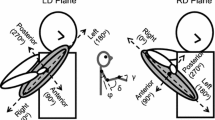Abstract
Processing of joint redundancy is one of the most important problems in motor control. For instance, gaze orientation can be obtained with an infinite number of eye and head combinations. It has been proposed that a solution to this problem might be the minimization of eye and head position-signal errors. For arm movements, where the excess of degrees of freedom is even higher, cost function was proposed as a criterion for movement selection, reflecting some comfort variable evoked from the peripheral inputs, e.g. optimal muscular energy cost or glucose consumption. However, no biological implication of comfort on motor control has yet been demonstrated. We have further investigated this approach by hypothesizing that arm posture choice also relies on a minimization of position-signal errors arising from individual joints. The prediction is that accuracy of fingertip localization by pointing made by the contralateral hand would be enhanced for comfortable postures of the target arm and degraded for uncomfortable postures using extreme joint positions. Results show an increase in pointing variability when extreme joint postures are used (wrist flexion, shoulder elevation, or both). This increase in pointing variability is proportional to the increase in subjective discomfort rating. Individual joint effects can be added arithmetically into a whole arm value for both discomfort rating and pointing variable and constant error. These results suggest that the choice of comfortable postures for the arm corresponds to an optimization of arm positionsignal reliability. This new constraint might be a useful tool for further investigation on posture or trajectory formation.
Similar content being viewed by others
References
Biguer B, Prablanc C, Jeannerod M (1984) The contribution of coordinated eye and head movements in hand pointing accuracy. Exp Brain Res 55:462–469
Bizzi E, Accornero N, Chapple W, Hogan N (1984) Posture control and trajectory formation during centrally initiated movements. J Neurosci 4:2738–2744
Cabanac M (1971) Physiological role of pleasure. Science 173:1103–1107
Cabanac M (1992) Pleasure: the common currency. J Theor Biol 155:173–200
Clark FJ, Burgess RC, Chapin JW, Lipscomb WT (1985) Role of intramuscular receptors in the awareness of limb position. J Neurophysiol 54 (6): 1530–1540
Cruse H (1986) Constraints for joint angle control of the human arm. Biol Cybern 54:125–132
Cruse H, Brüwer M (1987) The human arm as a redundant manipulator: the control of path and joint angles. Biol Cybern 57:137–144
Cruse H, Wishmeyer E, Brüwer M, Brockfeld P, Dress A (1990) On the cost functions for the control of the human arm movement. Biol Cybern 62:519–528
Flash T, Hogan N (1985) The coordination of arm movements: an experimentally confirmed mathematical model. J Neurosci 5:1688–1703
Gandevia S, Burke D (1992) Does the nervous system depend on kinesthetic information to control natural limb movements? Brain Behav Sci 15:615–632
Hoff B, Arbib MA (1992) A model of the speed-accuracy and perturbation on visually guided reaching. In: Caminiti R, Johnson PB, Burnod Y (eds) Control of arm movement in space. Neurophysiological and computational approaches. Springer, Berlin, pp 285–306
Hogan N, Mussa-Ivaldi F (1992) Muscle behavior may solve motor coordination problems. In: Berthoz A, Graaf, Vidal P-P (eds) Eye-head sensorimotor system. Oxford University Press, Oxford, pp 153–157
Jeannerod M (1988) The neural and behavioural organization of goal directed movements. Oxford Univ. Press, Oxford, pp 283
Jeannerod M, Rossetti Y (1993) Visuomotor coordination as a dissociable function: experimental and clinical evidence. In: Kennard C (eds) Visual perceptual defects. (Baillière's clinical neurology, international practise and research) Baillière Tindall/Saunders, London, pp 439–460
Jordan MJ (1992) Constrained supervised learning. J Math Psychol 36 (3): 396–425
Kluger PN, Kelso JAS, Turvey MT (1980) On the concept of coordinative structures as dissipative structures: I. Theoretical lines of convergence. In: Stelmach GE, Requin J (eds) Tutorials in motor behaviour. North-Holland, Amsterdam, 3–47
Mattews PBC (1988) Proprioceptors and their contribution to somatosensory mapping: complex messages require complex processing. Can J Physiol Pharmacol 66:430–438
Paillard J, Brouchon MA (1968) Active and passive movement in the calibration of position sense. In: Freedman SJ (eds) The neuropsychology of spatially oriented behavior, Chap. 3. Dorsey Press, Homewood, Ill, pp 37–55
Paillard J, Brouchon MA (1974) Proprioceptive contribution to the spatial encoding of position cues for ballistic movements. Brain Res 71:273–284
Rosenbaum DA, Vaughan J, Barnes HJ, Marchak F, Slotta J (1990) Constraints on action selection: overhand versus underhand grips. In: Jeannerod M (eds) Attention and Performance XIII. Erlbaum, Hillsdale, NJ, pp 321–342
Rossetti Y, Tadary B, Prablanc C (1994) Optimal contributions of head and eye positions to spatial accuracy in man tested by visually directed pointing. Exp Brain Res 97:487–496
Stelmach GE, Castiello U, Jeannerod M (1994) Orienting the finger opposition space during prehension movements. J Mot Behav (in press)
Uno Y, Kawato M, Suzuki R (1989) Formation and control of optimal trajectory in human multijoint arm movement — minimum torque-change model. Biol Cybern 61:89–101
Vallbo AB (1974) Afferent discharge from human muscle spindles in non-contracting muscles. Steady state impulse frequency as a function of joint angle. Acta Physiol Scand 90:303–318
Wann JP, Ibrahim SF (1992) Does limb proprioception drift? Exp Brain Res 91:162–166
Author information
Authors and Affiliations
Rights and permissions
About this article
Cite this article
Rossetti, Y., Meckler, C. & Prablanc, C. Is there an optimal arm posture? Deterioration of finger localization precision and comfort sensation in extreme arm-joint postures. Exp Brain Res 99, 131–136 (1994). https://doi.org/10.1007/BF00241417
Received:
Accepted:
Issue Date:
DOI: https://doi.org/10.1007/BF00241417




